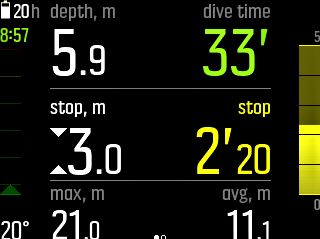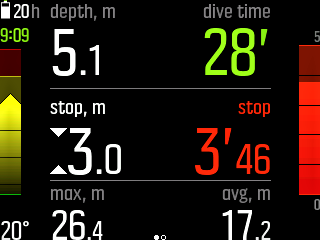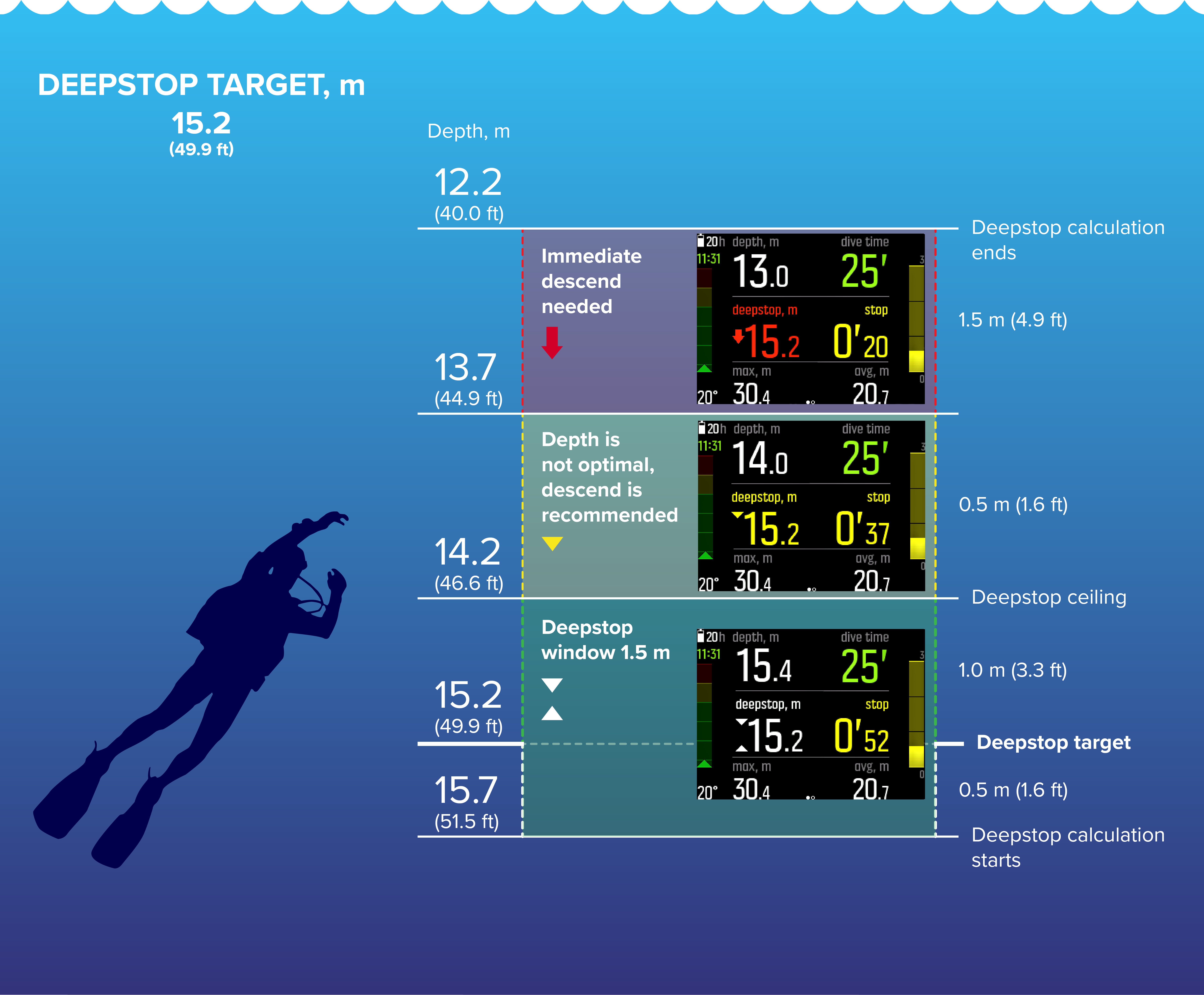Suunto EON Steel Black User Guide 3.0
Safety stops and deepstops
Safety stop and deepstop ceilings are always at constant depth when you are at the stop. Safety stop and deepstop times are counted down in minutes and seconds.
Safety stop
There are two types of safety stops: voluntary and mandatory. Safety stop is mandatory if ascent speed violation happened during the dive. Mandatory safety stop is shown in red, while voluntary safety stop is indicated with yellow.
A three (3) minute safety stop is always recommended for every dive over 10 meters (33 ft).
The time for a safety stop is calculated when you are between 2.4 and 6 m (7.9 and 19.8 ft). This is presented with up/down arrows on the left side of the stop depth value. Safety stop time is shown in minutes and seconds. The time may exceed three (3) minutes if you ascend too fast during dive. Ascent speed violation increases safety stop time with minimum 30 seconds. If violations happened several times, the additional stop time is longer. Safety stops can be set to three (3), four (4), or five (5) minutes.
Voluntary safety stop is shown in yellow:

Mandatory safety stop is shown in red:

Omitting mandatory safety stop does not lock the dive algorithm.
Deepstop
Deepstops activate only when you dive deeper than 20 m (66 ft). During ascend, deepstops activate when you are halfway up from your maximum depth. Deepstops are presented like safety stops. You are in the deepstop area when the deepstop depth has up/down arrows in front of it and deepstop time is running. The deepstop window is +/- 1.5 m (4.9 ft). Calculation starts at deepstop target depth plus 0.5 m (1.6 ft). Calculation ends - 3 m (- 10 ft) away from deepstop depth.
There can be more than one deepstop during ascend. For example, if you dive to 42 m (137.8 ft), the first deepstop is prompted at 21 m (68.9 ft) and the second is at 10.5 m (34.4 ft) The second deepstop is 2 minutes long.
In the following example the diver dives down to maximum 30.4 m (99.7 ft) and has a deepstop at 15.2 m (49.9 ft):

Below 20.0 m (66 ft), deepstop gets activated. In this case, as the diver ascends, the deepstop is necessary at halfway of the maximum depth, so at 15.2 m (49.9 ft).
If the deepstop depth is 15.2 m (49.9 ft), the calculation starts at 15.7 m (51.5 ft) and stops at 12.2 m (40.0 ft). The deepstop window is 1.5 m (4.9 ft) and when the diver is within the deepstop window, it is indicated with two white arrows pointing at each other on the display.
When the diver ascends above the deepstop window ceiling - in this case above 14.2 m (46.6 ft) - a downward pointing yellow arrow signals that the depth is not optimal, it is recommended to descend. The deepstop target depth number also turns yellow.
If the diver keeps ascending, after 0.5 m (1.6 ft), a downward pointing red arrow and an alarm notify the diver to descend immediately. The deepstop calculation keeps running for another 1.5 m (4.9 ft) up but stops after that. In the above example it stops at 12.2 m (40.0 ft).
For safety reasons, you cannot switch off deepstops if helium (trimix gas mixtures) is enabled for the dive mode in use. When helium is not in use, deepstops can be turned on and off. However, it is recommended that you turn deepstops on for all dives. If deepstops are turned on but omitted during a dive, it will affect your next dive which will be more conservative.